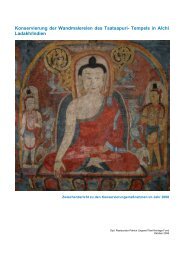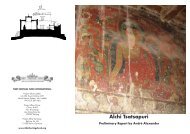Beijing Hutong Conservation Plan - Tibet Heritage Fund
Beijing Hutong Conservation Plan - Tibet Heritage Fund
Beijing Hutong Conservation Plan - Tibet Heritage Fund
You also want an ePaper? Increase the reach of your titles
YUMPU automatically turns print PDFs into web optimized ePapers that Google loves.
<strong>Beijing</strong> <strong>Hutong</strong> <strong>Conservation</strong> <strong>Plan</strong>:<br />
The future of Old <strong>Beijing</strong> and the conflict between modernization and preservation<br />
Introduction<br />
The topic of this plan is the conflict between the modernization of <strong>Beijing</strong> and the preservation of its cultural heritage. Over the past decade, rapid development<br />
has lead to a remarkable improvement in the quality of life for many citizens. At the same time, however, much of the historic urban fabric of the capital has<br />
been lost. Major roads now bisect ancient neighborhoods, whilst in many areas, recent redevelopment has wiped out the subtle architectural texture and spatial<br />
arrangement of the preceding centuries. The atmospheric <strong>Hutong</strong> lanes, the traditional residential homes, and the Si-He-Yuan courtyard houses - all are fast<br />
disappearing as the city races forwards into the 21st century. In recent years, the government has placed a number of <strong>Hutong</strong> lanes under protection, but what<br />
exactly this protection means is not clear. Many <strong>Beijing</strong> people are now concerned that, at the current rate, redevelopment will soon engulf and destroy the<br />
ancient courtyard houses forever. Groups and committees have formed to debate many of the practical issues surrounding redevelopment and conservation.<br />
Can a city the size of <strong>Beijing</strong> afford to have one-storey housing at its centre? Aren’t the courtyard houses much too dilapidated, and lacking in comfort, to be<br />
saved? How can the local resident community be protected from relocation? How can rights of ownership be balanced against the needs of commercial redevelopment?<br />
Whilst these questions are being discussed, the re-development goes relentlessly on.<br />
Many cities worldwide have found that rehabilitation, rather than re-development, of historic urban districts brings considerable benefits. This plan sets out to<br />
demonstrate that rehabilitation is also suitable for <strong>Beijing</strong>. The opinions of residents have been carefully researched and integrated into the plan. Some of the<br />
solutions proposed are self-contained, and could be used for the rehabilitation of individual courtyard houses. In order to preserve the character of a historic<br />
<strong>Beijing</strong> neighborhood, however, a larger cluster of <strong>Hutong</strong> neighborhoods must be targeted. This must be done with considerable urgency before the incursion<br />
of more major roads destroys the <strong>Hutong</strong>s’ original urban context. The value of the <strong>Hutong</strong> lies in the spatial arrangement as much or more than in the<br />
architecture of the individual courtyard house. Therefore, concerned parties must be very clear from the outset about which remaining quarters of historic<br />
<strong>Beijing</strong> they intend to preserve.<br />
<strong>Beijing</strong> is one of the world’s most important historical cities, with a unique ambience balancing ancient and modern. Having reached this point of balance,<br />
<strong>Beijing</strong> planners must surely pause for thought. It would indeed be a great loss if this ancient capital were to become just another face-less mega-city.<br />
6




